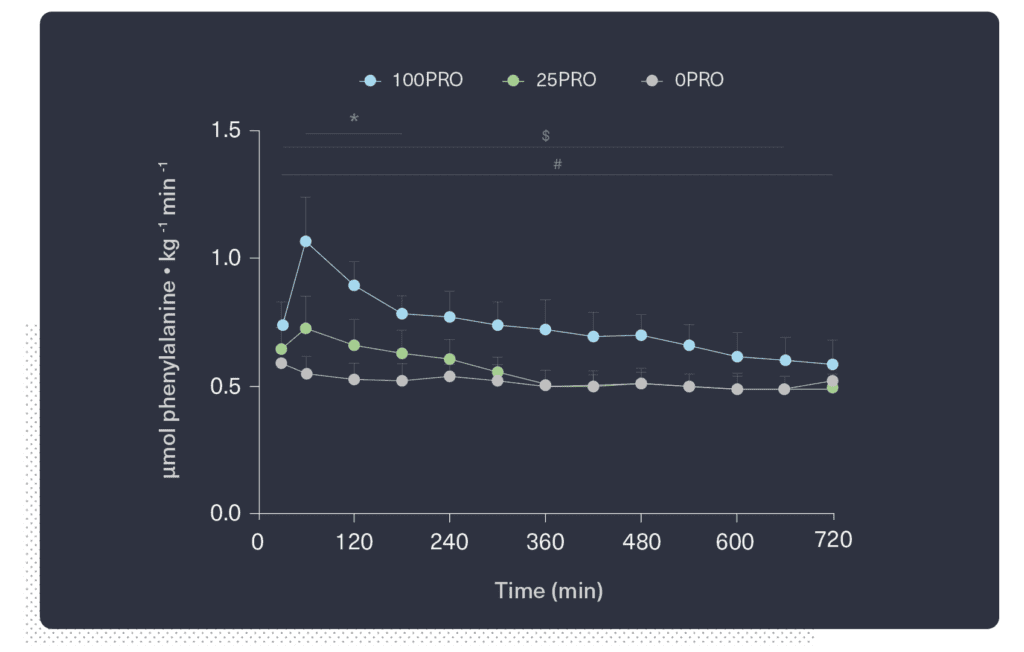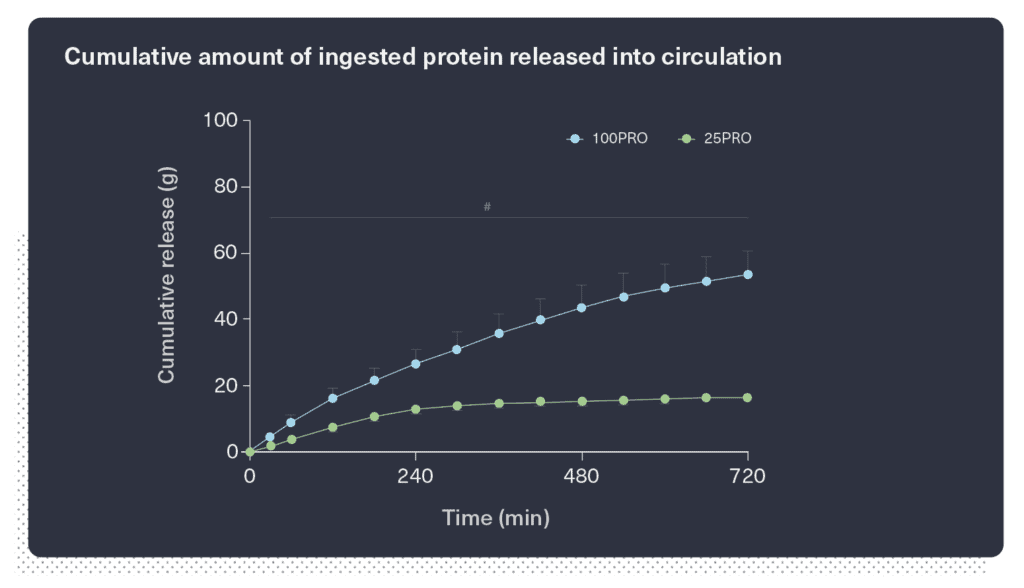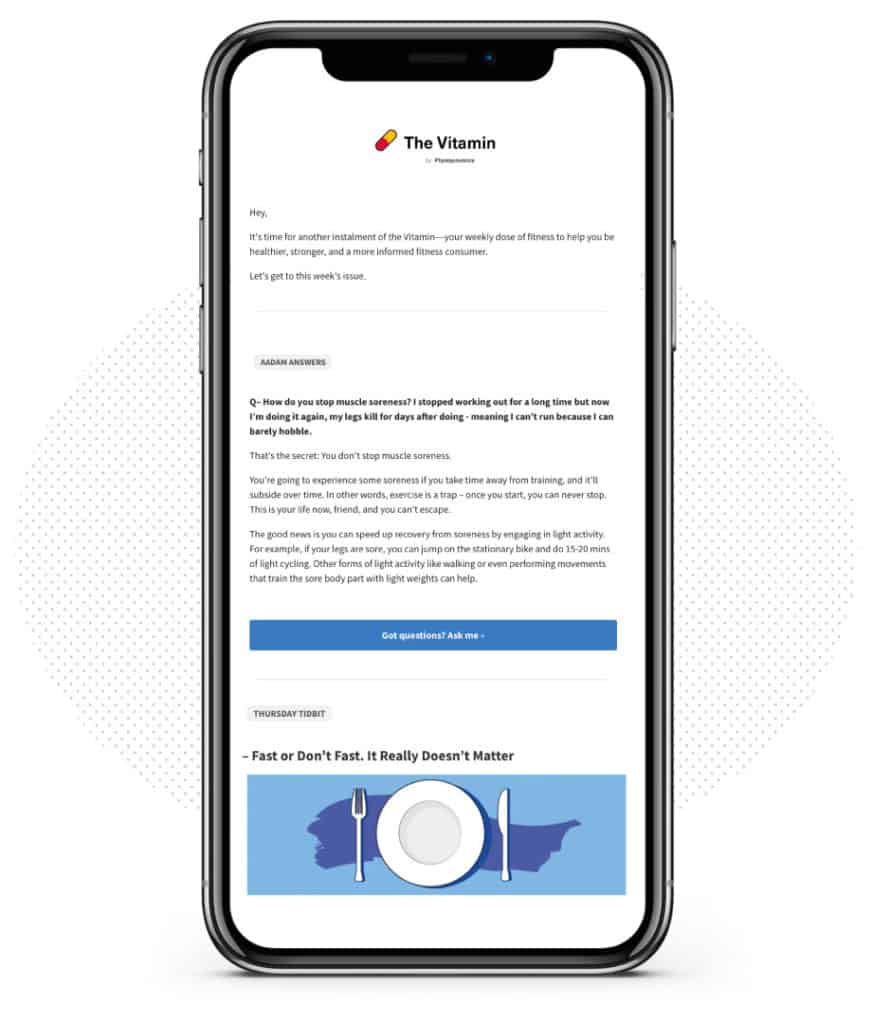There’s a popular belief in the fitness world that there’s a limit to how much protein the body can absorb in a single meal, and anything over this is wasted.
I’m not sure where this idea stems from––perhaps because earlier protein research showed that muscle protein synthesis (i.e., the creation of new muscle proteins) is maximally stimulated around 20-25g of protein.
However, muscle protein synthesis is different to absorption.
When you eat or drink protein (and any other nutrient), it’s first broken down by your stomach. After that, the food/liquid is passed on to the small intestine, where much of the chemical breakdown of the ingested protein occurs.
From here, it’s broken down into amino acids (the building blocks of protein), and absorption occurs across the wall of your intestines and into the bloodstream. Once in the bloodstream, the amino acids make what’s called a first pass through the liver. Basically, the liver gets first dibs on all absorbed nutrients and might use these to build things (like proteins for key processes), create energy, or alter them into other compounds.
Once nutrients make their first pass, they continue in the bloodstream and make their way to muscle, where they can be taken up by the muscle to create new muscle proteins (anabolic/building process) or be metabolised for energy (catabolic/breaking down process).
As such, absorption and muscle protein synthesis are two distinct phases of the journey dietary protein takes before it meets its new fate.
So then, how much protein can the body really absorb and use for muscle building?
A new study investigated the effects of ingesting either 100g, 25g, or 0g of protein following weight training sessions on various outcomes related to muscle protein synthesis. 1
Now, there have been numerous studies on this topic. However, this new study was unique in that it provided a much larger serving of protein over a longer period of time.
Let’s talk about it.
What did the researchers do?
36 healthy and recreationally active young men showed up to the lab, where their blood samples were taken while they received an IV drip containing amino acid isotopes. These isotopes are designed to track how the body processes amino acids (the building block of protein).
After 90 minutes, the participants completed a full-body resistance training session and were randomized to one of three groups receiving three different amounts of milk protein:

After the workout, small samples of muscle were taken from the participants right away and then again 4, 8, and 12 hours later. They also had their blood drawn 30 and 60 minutes after the training session and every hour up to 12 hours after the workout.
The researchers wanted to see what happens when the participants consumed the proposed optimal amount of protein (25g) compared to a considerably larger amount (100g) in one sitting.
👉 Muscle protein synthesis was significantly higher in 100g compared to 25g and 0g for the first 10-12 hrs.

👉 Protein breakdown was similar between the three groups at all time points, and so too was oxidation.
👉 About 15% of the absorbed protein was oxidised, while the remaining 85% was used for tissue building.
👉 There was a dose-dependent muscle protein synthesis response over the 12 hrs (100g > 25g > 0g).
What does this mean?
The key finding of this study was the muscle-building process following a weight training session was elevated for at least 12 hours following the ingestion of 100g of protein, and this elevation was higher than that seen with 25g of protein.
This makes sense when you consider the more protein (or food) you eat, the longer it will take for it to be digested. With 100g of protein, amino acids were still being released into circulation even at the 12-hour mark. In contrast, the 25g intake plateaus around the 4-hour mark, suggesting the digestion and absorption process was largely completed, with most of the available amino acids released into circulation. You can see this in the image below (taken from the study).

Basically, the body absorbed most of the 100g of protein, suggesting the upper limit to the muscle-building process following weight training is much higher than previously thought.
Previously, 20-25g of protein was thought sufficient to maximally stimulate muscle protein synthesis. 2 3 4 However, those studies were limited by relatively shorter assessment periods (<6 hrs) compared to this new study (12 hrs).
Contrary to the current recommendation to spread your total protein intake into smaller feedings to maximise muscle protein synthesis, this new study suggests larger protein servings in fewer meals across the day can still stimulate the muscle growth response.
That said, it’s worth remembering while this was a really well-conducted study, it’s still an acute study that answers a specific question (is there a limit to how much protein the body can absorb?). It doesn’t tell us whether spreading your protein intake across 3-4+ meals is better than 1-2 meals for muscle growth or whether you can gain the same amount of muscle by eating 1-2 meals per day as you would eating 3-4+ meals per day.
In this study, the muscle protein synthesis response was higher in the 100g protein group. However, an increase in muscle protein synthesis doesn’t always mean more muscle growth. For example, one review points out that acute MPS measurements may have limited value in predicting changes in muscle mass after resistance training. 5
With all the caveats and disclaimers out of the way, where does this leave us?
For starters, total protein intake is the most important factor for gaining muscle (or retaining muscle in a deficit) since it ensures you stay in a positive muscle balance (where muscle protein synthesis outpaces muscle protein breakdown).
After that’s been taken care of, how you distribute your protein throughout the day will depend on personal preference or what’s most practical for you and your lifestyle.
For instance, maybe someone else cooks dinner for you, and you have less control over the meal’s protein content, so increasing your protein at breakfast and lunch ensures you’re hitting your daily protein target, even if you end up eating a bit less protein at dinner.
I still think 3-4 meals per day is most practical for most people. At this frequency, eating enough protein is more manageable. But if you’re someone who enjoys or prefers 1-2 meals per day, this new study suggests you can still make solid gains (as long as you’re eating enough protein).
In summary
- A new study challenges the notion the body can only absorb 20-30g of protein per meal with the rest being wasted.
- In this study, there was a dose-dependent increase in muscle protein synthesis over 12 hrs (100g > 25g > 0g), suggesting there’s no upper limit to the anabolic response to protein ingestion.
- We should be mindful of extrapolating these findings to mean “protein distribution doesn’t matter at all” since this study was answering a totally different question (is there a limit to protein absorption in a single meal?)
- Your total protein intake is still the most important factor for muscle gain and/or retention.
- How you distribute your protein throughout the day is ultimately a matter of preference, but for most people, 3-4 protein-containing meals are likely best from a practical standpoint.
- If you prefer eating 1-2 meals per day, you’ll likely still be able to make solid gains as long as you eat enough total protein.
Thanks for reading. If you enjoyed this, you’d love the Vitamin

One email every Thursday, filled with actionable, evidence-based fitness advice (just like this article) to help you with your goals. If you enjoyed this, you’ll love my emails. You can learn more and subscribe for free here.